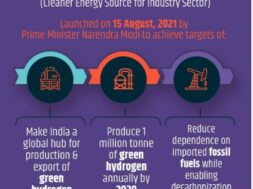
Clean energy: India approves an Rs.19.7 k crore mission for green hydrogen
Virendra Pandit
New Delhi: In a significant development, the Government of India on Wednesday approved the National Green Hydrogen Mission (NGHM) with an initial outlay of Rs 19,744 crore, aiming to make the country a global hub for manufacturing this clean source of energy.
Prime Minister Narendra Modi launched this Mission on August 15, 2021, to provide a clean energy source for industries.
“At a meeting, chaired by Prime Minister Narendra Modi, the Union Cabinet approved the NGHM,” Union Minister Anurag Thakur told reporters while briefing them about the fresh decisions.
The initial outlay for the Mission (Rs 19,744 crore) includes Rs 17,490 crore for the Strategic Interventions for the Green Hydrogen Transition Programme (SIGHT) program, Rs 1,466 crore for pilot projects, Rs 400 crore for R&D, and Rs 388 crore for other mission components.
The Ministry of New and Renewable Energy (MNRE) will formulate the scheme guidelines and will be responsible for the overall coordination and implementation of the Mission, he added.
The Mission’s objective is to promote green hydrogen production capacity development of at least 5 MMT (Million Metric Tonnes) per annum with an associated renewable energy capacity addition of about 125 GW in the country by 2030.
It envisages an investment of over Rs 8 lakh crore and the creation of more than 6 lakh jobs by 2030, which will also result in a cumulative reduction in fossil fuel imports of over Rs 1 lakh crore and a reduction of nearly 50 MMT of annual greenhouse gas emissions by 2030, he said.
The Mission will have wide-ranging benefits—the creation of export opportunities for green hydrogen and its derivatives; decarbonization of industrial, mobility, and energy sectors; reduction in dependence on imported fossil fuels and feedstock; development of indigenous manufacturing capabilities; creation of employment opportunities; and development of cutting-edge technologies, the government said in an official statement.
The body will facilitate demand creation, production, utilization, and export of green hydrogen. Under the SIGHT program, two distinct financial incentive mechanisms –targeting domestic manufacturing of electrolyzers and production of green hydrogen—will be provided.
The Mission will also support pilot projects in emerging end-use sectors and production pathways. Regions capable of supporting large-scale production and/or utilization of hydrogen will be identified and developed as Green Hydrogen Hubs, Thakur said.
It will develop an enabling policy framework, robust standards, and regulatory framework to support establishing the green hydrogen ecosystem.
Also, a public-private partnership framework for R&D (Strategic Hydrogen Innovation Partnership, or SHIP) will be facilitated under the Mission. R&D projects will be goal-oriented, time-bound, and suitably scaled up to develop globally competitive technologies. A coordinated skill development program will also be undertaken.
All the ministries concerned, departments, agencies, and institutions of the Central and state governments will undertake focused and coordinated steps to ensure the successful achievement of the Mission objectives.














